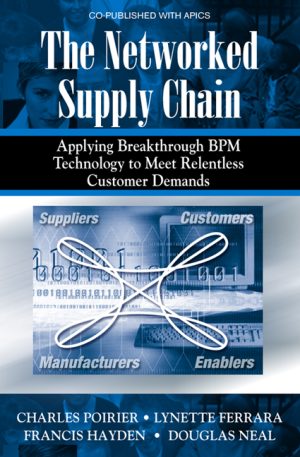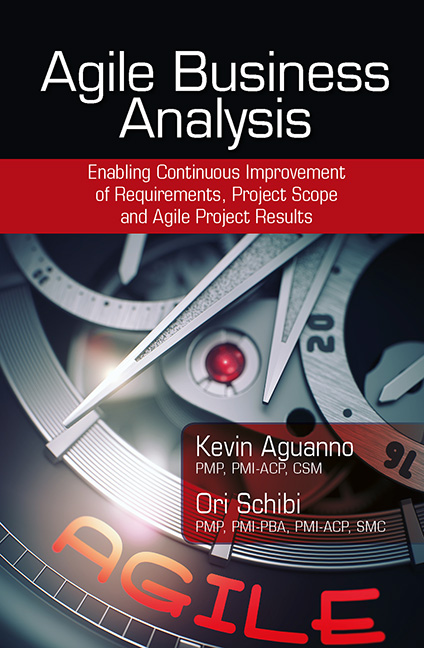Agile Business Analysis
$39.95
Enabling Continuous Improvement of Requirements, Project Scope, and Agile Project Results
Kevin Aguanno, PMP, PMI-ACP, CSM and Ori Schibi, PMP, PMI-PBA, PMI-ACP
Hardcover, 6×9, 344 pages
ISBN: 978-1-60427-148-5
November 2018
LEARN & EARN: Get 7.0 PDUs in the PMI skill areas of Leadership or Strategic and Business Management Skills
Description
Agile Business Analysis discusses trends in the business analysis and agile environments, how these two areas align and promote each other, and identifies areas of responsibility and ownership for the business analyst (BA). It triggers readers to review the role of the BA in their environments and shows how to create value in agile environments through the introduction of business analysis skills into agile project processes and activities.
Readers will learn ways BAs can provide support to agile projects through modeling techniques; documentation; communication, meetings, and reporting; governance; building user stories, elaborating requirements, and facilitating the estimating process; ensuring effective application of lessons, improvements, and efficiencies; and much more.
The book is designed for BAs of all levels, from all types of environments, and for agile practitioners, including Scrum Masters, coaches, project managers, product owners, and technical team members who interact with BAs on their projects.
Key Features
- Details concepts that are aligned with the PMBOK® Guide, Business Analysis for Practitioners: A Practice Guide, the BABOK® Guide, and the PMI-PBA, PMI-ACP, CBAP, and Scrum Master professional certifications
- Proposes solutions to challenges around attempting to introduce agile methodologies to an organization, including criteria to selecting the right approach, organizational change, team performance, agile processes, corporate governance, and organizational alignment
- Discusses how agile projects’ performance can benefit from business analysis skills, as well as the enhanced role the BA can have in agile environments
- Demonstrates potential gains the agile team can make toward maximizing the benefits of agile ceremonies and work products by complementing the team’s areas of responsibility with focused involvement by a BA
- Provides a practical approach to addressing the intersections among the various agile roles and the ability to maximize each role’s contribution with the added value provided by the agile business analyst
- Illustrates the flow of work and responsibilities between the BA and the agile team in the process of eliciting, documenting, analyzing, communicating, validating, and managing requirements, including the application of modeling techniques to enhance the ability to produce good agile requirements
- Explores an approach to analyzing organizational readiness to agile projects, including an assessment of the governance structure, and provides techniques to bridge any gaps that are discovered through the analysis
- Introduces concepts for performing agile documentation with a focus on reducing waste, challenging existing processes and templates, and ensuring that the documentation still meets compliance and regulatory constraints
- WAV offers a downloadable agile triage checklist, iteration burndown spreadsheet, slides covering key concepts, and a glossary—available from the Web Added Value™ Download Resource Center
About the author(s)
Kevin Aguanno, PMP, PMI-ACP, CSM, has over 20 years of experience managing complex systems integration and software development projects. He is well known in the industry for his innovative approaches to solving common project management problems and focuses on two project management specialty areas: agile project management and troubled project recovery.
As a well-known keynote speaker, author, trainer, and coach in agile management methods, Aguanno has taught thousands of people how to better manage high-change projects by using techniques from Scrum, Extreme Programming, Feature-Driven Development, and other agile methods. He is a frequent presenter at conferences and private corporate events where he delights audiences with practical advice peppered with fascinating stories from his own experiences in the trenches practicing agile project management. He is also founding Director and Vice President of the Project Management Association of Canada.
Ori Schibi, PMI-PBA, PMP, PMI-ACP, SMC, is President of PM Konnectors, an international consulting practice based in Toronto. With focus on project management, business analysis, and change management, his company provides a variety of services, including facilitation, workshops, training, and consulting, which deliver value to clients through a wide range of innovative business solutions. Many large to mid-sized organizations in diverse industries and levels of governments have benefited from PM Konnectors innovative services.
Mr. Schibi is a thought-leader and subject matter expert in business analysis and both traditional and agile project management. He is the author of Managing Stakeholder Expectations for Project Success, co-author of Effective PM and BA Role Collaboration, and a speaker and consultant with over 25 years of proven experience in driving operational and process improvements, software implementations, and complex programs to stabilize business, create growth and value, and lead sustainable change.
Table of Contents
Chapter 1: Introduction to Agile and the Agile Process
Chapter 2: Agile Challenges
Chapter 3: Roles and Responsibilities
Chapter 4: Agile Requirements and User Stories
Chapter 5: Agile Documentation
Chapter 6: The BA’s Role in Planning and Estimating
Chapter 7: The BA and the Agile Events and Work Products
Chapter 8: Testing and Solution Evaluation
Chapter 9: A Day in the Life of the Agile BA
Chapter 10: Moving Forward
Reviews
“As a business analyst, I kept hearing that there is no place for me on agile projects, but this book showed me how crucial my role still is. Lots of people say they understand how a BA can improve agile projects, but these guys actually get it.”
—Tak Keung Sin, Business Analyst & Compliance, HK Financial Services Regulator
“This book offers a unique perspective of how, when, where, and why a BA is needed in the agile journey. It facilitates greater cultural acceptance for the BA role and increases the overall chances of project success.”
—Stephanie Newland, CSM, Practice Manager for a Leading Technology Services Organization
Related products
-

Aircraft Finance
Retail Price: $99.95$89.95 Add to cart -

The Networked Supply Chain
Retail Price: $54.95$44.95 Add to cart -

Handbook of Integrated Risk Management for E-Business
Retail Price: $89.95$69.95 Add to cart -

Financially Focused Project Management
Retail Price: $54.95$44.95 Add to cart -

Distressed Debt Analysis
Retail Price: $119.95$99.95 Add to cart

